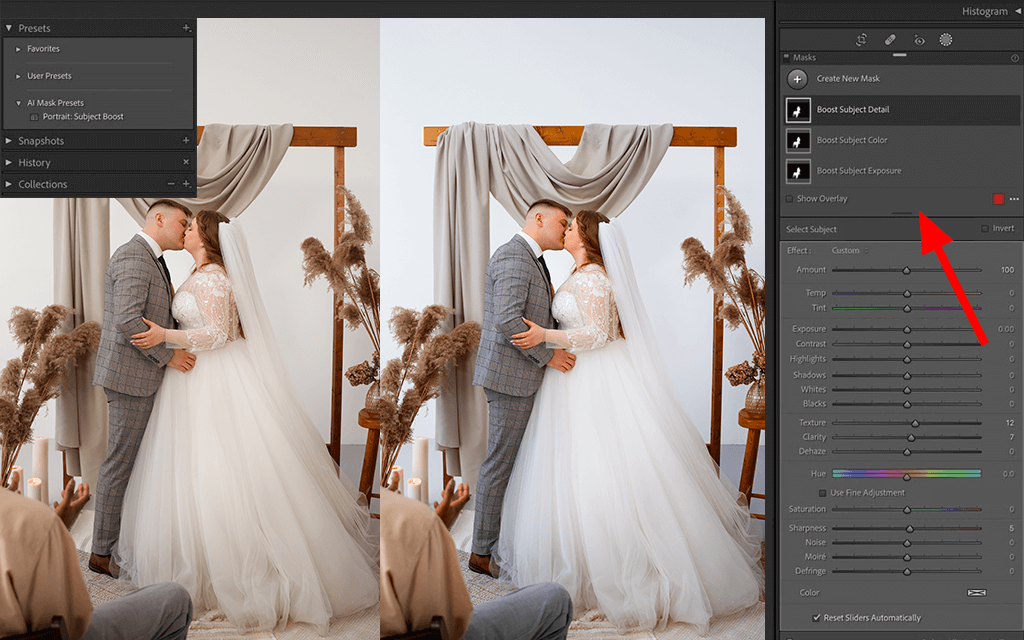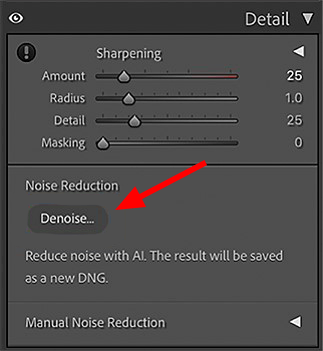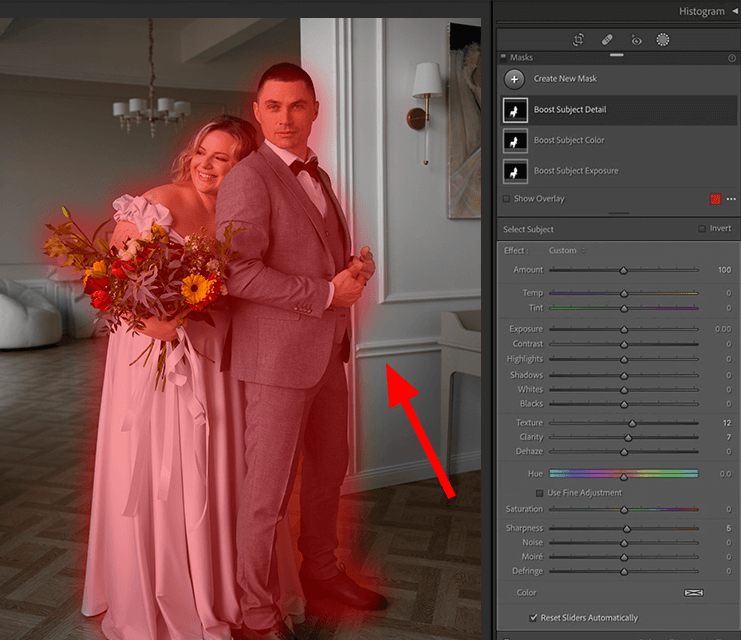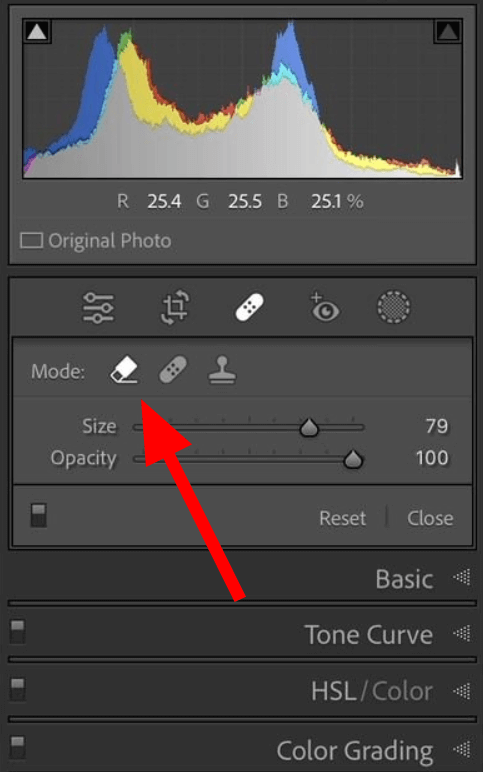I’ve tested the following main tools: generative object removal, lens blur, AI-based masking, and adaptive presets. The results of using AI in Lightroom have been remarkable: the time I spend editing images was reduced by two, while the quality of the photos has improved thanks to the precision and intelligence of the new editing tools.
By using innovative features like automatic subject recognition, adaptive presets, and improved noise reduction, I managed to make my editing process a lot quicker and more accurate, allowing myself to focus on the creative aspects of my work instead of the technical details and sleep more.
Below are some of the tools I use to create the perfect wedding photos.

Lightroom automatically detects the main subject (bride, groom) or the sky, which significantly simplifies the process of selectively editing wedding photos. Previously, I had to manually select subjects, which required time and effort, but now I only need a single click to have the software determine the most important parts of an image on its own. This allows me to get the desired result quicker and spend less time on technical tasks.
My experience: I often use Select Subject when working on portrait photos of brides and grooms, whenever I need to darken or soften the backdrop without affecting the main subject. This is especially useful when creating a softer atmosphere in a photo when it’s important to highlight emotions while ensuring the background isn’t distracting.
Select Sky is perfect for boosting the intensity of the sky, especially if the photoshoot is held outdoors. Important details like sunset colors or clouds become sharper without overpowering the rest of the composition.

Adaptive Presets automatically adjust the effect to specific wedding photos. They account for the lighting, color scheme, and other factors, which allows for making quick image enhancements that don’t require manual involvement.
My experience: These presets work great on wedding portraits. They increase contrast without disfiguring natural skin tones, which is essential for wedding photography. I use them when working on a series of photos to quickly create a unified style for all of them while preserving their atmosphere and color balance.

By learning how to use AI Denoise in Lightroom, you’ll be able to get rid of digital noise while preserving important details like skin texture or hair. Compared to classic noise removal methods, AI Noise Reduction provides significantly better results without sacrificing clarity or realism.
My experience: Removing noise canceling in Lightroom by leveraging the AI Noise Reduction feature is perfect for wedding photos taken in spaces with insufficient lighting or at higher ISO values. It ensures the images remain clean and clear even if they were taken in darker environments or late in the evening.

AI mask in Lightroom allows you to automatically select and edit individual image parts like the background, skin, and clothing. This feature is a lifesaver for retouching, as it allows you to enhance separate elements without affecting the rest of the photo.
My experience: This tool is extremely convenient for wedding photographers. I use it to change the lighting on the faces of the newlyweds without affecting the landscape or décor in the background. This allows me to preserve the natural look of the photo and preserve the harmony between its different elements.

Previously, to get rid of unwanted elements like people or various background objects, you had to open Photoshop or some other Lightroom alternatives. Nowadays, you can learn how to use AI in Lightroom to remove objects by leveraging the Content-Aware Remove tool that will save you a ton of time and effort.
My experience: This tool is very useful for editing outdoor wedding photos that are often full of unwanted elements like random passersby or cars. I can quickly clean up my photos without losing the background’s texture. This is the perfect tool for fast edits that allow preserving a natural look without requiring extensive manual editing.

Auto Tone automatically adjusts the white balance, contrast, shadows, and brightness – laying the perfect foundation for further editing. This tool is perfect for making the initial corrections, especially if you need to quickly evaluate the quality and accuracy of the lighting, colors, and contrast.
My experience: This feature has been very useful for making the initial edits to my wedding photos. It sets a great basis for more detailed adjustments, as it significantly speeds up the retouching process and helps quickly evaluate the potential of a photo to determine if it’s worthy of more intricate edits.
If I were to pit Lightroom CC vs Lightroom Classic to determine the benefits of both options, I’d note that the former does a better job of automating the image editing process while the latter preserves more manual tools for making precise adjustments.
When working on wedding photos, I understand that each shot conveys a special emotion and demands diligent care to preserve the best moments of the most special day for the newlyweds.
I decided to test the new AI tools in Lightroom to learn how these technologies can help improve my image editing workflow. My main goal was to determine how efficient AI is at automating standard adjustments to the exposure, contrast, and white balance without lowering the quality of the image. My conclusions are based on our standard approach to testing.
I wanted to not only evaluate the AI’s capability to quickly edit the main image parameters, but also ensure these tools can preserve the unique atmosphere of wedding pictures: the soft colors, natural lighting, and sharp portrait details. That’s why I tested them on a variety of photos from newlywed portraits to group shots and close-up interior pictures. This helped me see how the AI tackles different types of lighting and compositions.
I focused on comparing the results provided by automatic AI-made corrections with manually edited photos to understand how efficient these tools are at saving time without lowering the quality of my work. Next, I covered each stage of the test from image culling to result analysis to showcase if the AI tools in Lightroom are suitable for professionally editing wedding photography.
Adobe Lightroom is among the most powerful photo editing software for PC that combines manual editing capabilities with innovational AI technology for automating most processes. I decided to compare how traditional editing methods hold up against someone who wants to learn how to use AI in Adobe Lightroom and how both approaches can be combined to get the best result:
| Criteria | AI Tools in Lr | Traditional Editing in Lr |
|---|---|---|
|
Editing speed
|
✔️ Quick image adjustments (for instance, AI Enhance)
|
❌ Requires more time for manual corrections
|
|
Adjustment accuracy
|
✔️ Automatically adjusts white balance, exposure, and colors, but might require some manual tweaking
|
✔️ High accuracy due to manual control over each parameter
|
|
Editing flexibility
|
❌ Limited creativity, template-based workflow
|
✔️ Full freedom to choose editing techniques and create customized presets
|
|
Creativity and personalization
|
❌ Less creative capabilities
|
✔️ Allows receiving unique results by manually adjusting each aspect of the photo
|
|
Batch photo editing
|
✔️ Perfect for batch processing large quantities of photos
|
❌ Unsuitable for batch editing without additional automation
|
|
Learning curve
|
✔️ Easier to learn for beginners thanks to the intuitive nature of AI tools
|
❌ Requires more time to learn and receive high-quality results
|
|
Final result
|
✔️ Good for fast image enhancements, but the results can look less unique
|
✔️ Allows receiving a unique style with flexible control over each parameter of the photo
|
 The entire FixThePhoto team, me included, appreciates Lightroom's AI functionality for how much time it allows to save. It lets me quickly and easily enhance wedding photos without compromising on quality. Such features as Select Subject and AI Noise Reduction let me dedicate my time to editing the smaller details of the images while preserving their sharpness and clarity.
The entire FixThePhoto team, me included, appreciates Lightroom's AI functionality for how much time it allows to save. It lets me quickly and easily enhance wedding photos without compromising on quality. Such features as Select Subject and AI Noise Reduction let me dedicate my time to editing the smaller details of the images while preserving their sharpness and clarity.